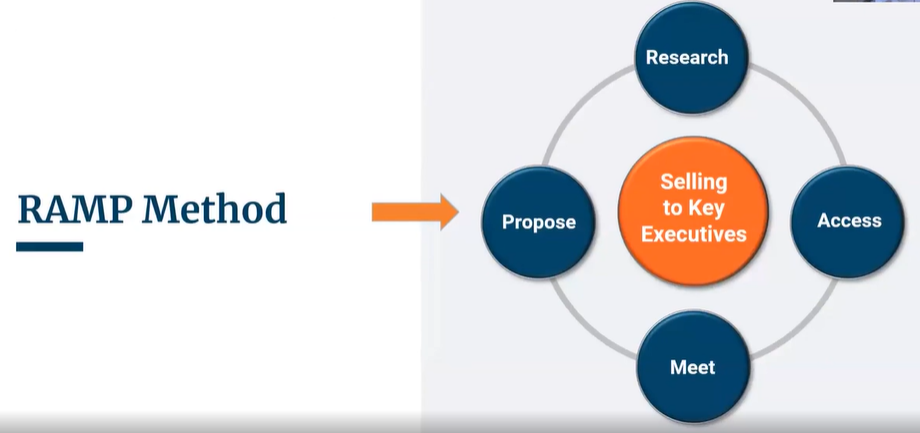Mastering the Art of Selling to the C-Suite: Strategies for Success


In today's ever-evolving business landscape, decision-making involves many stakeholders, making it crucial to adapt and thrive. Dive into this comprehensive guide to learn the essential skills to 'sell higher' in any organization and successfully gain access to C-Suite and executive-level buyers.
Table of Contents
- Who Is in the C-Suite?
- What Does Selling to the C-Suite Mean?
- Why Sell to the C-Suite Executives?
- What Does the C-Suite Care About?
- How Do You Approach the C-Level?
- Is E-Mail Effective for Reaching Key Executives?
- How Do You Stand Out to C-Level Executives?
- How Do You Pitch to Executives?
- What Questions Should I Ask the C-Suite?
Who Is in the C-Suite?
The C-Suite is the group of senior executives in the most critical management positions with job titles that usually begin with "chief" or “c” for short. This includes the Chief Executive Officer (CEO), Chief Technology Officer (CTO), Chief Financial Officer (CFO), Chief Marketing Officer (CMO), etc.
It is important to map each organization to understand the structure since executive roles and responsibilities differ across all companies. In many businesses, C-level executives are typically higher than VP and EVP but are collectively referred to as key executives.
Many new C-Level roles and titles did not exist ten years ago. The size of the organization typically drives these differences. For example, the Regional Vice Presidents may be the key executives in a large global or multi-division company. At the same time, smaller and mid-sized organizations may have the more traditional C-Suite structure.
What Does Selling to the C-Suite Mean?
Selling to the C Suite is connecting and meeting with top-level executives of any organization you want to do business with. Selling to executives requires a unique mindset, more strategic sales tactics, and a deep understanding of the executive buyer's motivation.
Selling to a key executive means shifting from a traditional sales approach to a valued partner role. This is a fundamentally different conversation to align with the C-Suite priorities, which center around:
- Marketplace insights
- Competitive or industry trends
- New ways of thinking about the customer business
- Solutions that impact the business
Why Sell to the C-Suite Executives?
Selling to C-Suite has never been more critical. Purchasing decisions at many organizations now include the C Suite level as the final decision maker. Sales win rates are much higher when a C-Suite member is directly involved in the buying process.
In addition to making the sale, there are several valuable benefits of selling to the C-Suite, including:
- Position as a strategic partner instead of a vendor
- Higher margin deals
- Shorter decision-making process
- Insulation against the competition
- Additional long-term business opportunities
What Does the C-Suite Care About?
Key executives operate at a strategic level. They care most about solving business problems and challenges – in the short term and well into the future. Emerging technology, industry changes, and competitive threats are top concerns. The C-Suite looks across all these areas to predict future outcomes from an organization-wide perspective. It is also important to note that different C leaders have different concerns. For example, what drives the CFO is different from the CIO.
To have a productive conversation with C-Suite executives, it is imperative to shift your mindset from the tactical (i.e., your product’s features) to the strategic big picture. Strategic thinking to connect with a key executive’s top concerns requires significant research. When doing your research, look for compelling answers to these essential questions:
- What business outcomes can you help the key executive achieve? Quantify the business impact of your solution and how it impacts the most important KPIs.
- What makes you, your company, or your solution different? How will your solutions affect the organization and stakeholders? Focus on the bigger picture, like the senior executive.
- Can the organization quickly and effectively work with you? Price is important, but it is not everything. Top executives don’t want more problems and want partners who are easy to work with.
- What is the long-term value of working with your organization? Are you a partner with companies that offer long-term benefits such as technological or competitive advantages?
How Do You Approach the C-Level?
Accessing senior executives is challenging since they are over-scheduled and typically avoid vendor meetings. The most successful approaches for connecting with the C-Suite are using referrals, creating a compelling reason to meet, and bringing fresh and valuable insights.
1. Referrals
Referrals are by far the most effective way to get a C-Suite appointment. Identify someone who knows and values you, your solution, or your company to introduce you to the key executive. Here are the best referral options:
- The most powerful referral is likely to come from your customer coach. Customer coaches know the political landscape of the customer organization and the key executive and are willing to share that information with you.
- Other stakeholders in the buyer organization can also be good referral sources.
- Identify relevant referrals within your network of professional contacts, such as LinkedIn and professional associations, as well as current and former clients, colleagues, and contacts.
Use referrals consistently to position yourself as a valuable and trusted sales professional.
- Be generous with your referrals: Offer to make referrals for your partners, colleagues, or vendors. Model the type and quality of referrals you would want from others.
- Be proactive: Ask satisfied clients to refer you. Ask them if they know anyone who might benefit from speaking with you and sharing insights and ideas. If your customer mentions a possible referral, ask for the person’s name and contact information, then follow up within 24 hours.
- Make it easy: Offer to do the work. Provide suggested language and examples.
- Make it a habit: Ask for referrals as part of the sales conversation. It is easier than contacting the client after the fact. Ask for a referral from every satisfied customer, partner, or colleague.
- Thank the referring person: Also, follow up and let the referring person know the referral results.
2. Create a Compelling Reason to Meet
The C-Suite is bombarded with meeting requests. Highlight a specific event or opportunity with a compelling reason to say "yes" to meeting with you. Reasons to meet might include:
- A strategic account review: Frame the meeting to highlight the value you have delivered for their organization and explore how to continue to move their business forward.
- A trigger event: Did your industry or company research identify an emerging problem or opportunity?
- An executive briefing: For instance, “Our Chief Technology Officer is going to be in town next week and would like to meet with you to discuss our new security features and development roadmap.”
3. Provide Insights or Other Valuable Information
Insights may include an industry trend, a research report, or a white paper from your research. Offer to share best practices, success stories, competitive insights, or industry information you have gathered from your own experience. The key is to connect the dots, linking the insights to the C-level executive’s challenges or goals.
Is E-Mail Effective for Reaching Key Executives?
Email is a great way to reach decision-makers, but you compete for attention with hundreds of daily emails. Your email can be deleted without a stand-out subject line before it is even opened or delegated to a lower-level manager. Creating an engaging, relevant, and timely subject line is essential to draw attention.
Along with a stand-out subject line, use these tips for a more compelling email:
- Keep the email length brief yet demonstrate a complete understanding of the business priorities, problems, goals, or industry issues.
- Give the executive a compelling reason to respond, such as a referral, event, or important new information.
- Include an intriguing question that can be a follow-up to something the executive has said or related to information found in the annual report, 10K investor report (if a publicly traded company), company blog, press releases, personal quotes, etc.
- Close with an easy and immediate next step and meeting request.
- Research the individual to determine the best value proposition for your email. This is not a one-size-fits-all approach, so tailor your email to resonate specifically with the individual.
How Do You Stand Out to C-Level Executives?
To stand out from all the noise, you must be relevant and bring fresh insights. Every C-Suite member faces unique challenges; research is the only way to learn about them. Start with the annual report, social media, websites, and investor presentations. Investigate industry news for account triggers like changes in leadership, funding, new product launches, or expansions into new marketplaces.
To uncover the insights that can lead to a meeting, you must be a PEST and research across the Political, Economic, Social, and Technological landscapes. The chart below details what to look at across the company and industry.

How Do You Pitch to Executives?
Most salespeople don’t have frequent C-Suite meetings and often plan for a high-level demo or discovery call. That is a mistake. With proper planning and preparation, a key executive meeting can provide an inside track on a sales opportunity or build a critical relationship. Follow the RAMP Method (Research, Access, Meeting, and Purpose) for a positive outcome that makes the most of your limited meeting time.

1. Research
This first step is the basis for all the rest and takes the most time. Identify the client profile and scout the individuals you want to sell to within that account. Map the organization to learn who is in key roles and what they care about. Next, do the PEST analysis to learn about the company and industry.
As you research, think of ways you can address their initiatives. Will the CFO be interested in increasing efficiency or reducing costs? Are there opportunities for the chief sales officer to ramp up a new sales team or scale the entire organization? Is the VP of product development positioning for a new product launch? Could the CEO be concerned about the company’s image or exploring an expansion into a new market?
2. Access
Access has always been challenging, and today, it may be done virtually. Referrals that introduce you are still the most effective way to get C-Level access. LinkedIn and other social platforms are invaluable for this. You can also leverage customer coaches who know the organization and can provide insights into its culture and operations. And don’t forget about your own senior executives. Peer-to-peer outreach can be instrumental in getting a response.
3. Meeting
While getting access is challenging, the hard work is not over yet. But having a plan before you get to the meeting will help tremendously. Here are a couple of tips:
- Have a clear objective and understand what you are trying to achieve.
- The executive may not remember why they agreed to meet with you; start with a quick recap (referral, conversations, etc.)
- Summarize the problems and opportunities the executive cares about most.
- You are there to give valuable information and accomplish your goal. Balance the two without launching into a product pitch.
- Repeat what the executive has told you and connect your solution back without using any technical or industry jargon.
- Keep it short. The executive will decide whether to continue the conversation within the first two or three minutes.
- Be flexible, as the conversation may go in a different direction than you planned.
- Thank the executive for their ideas and feedback
- Summarize the highlights and identify the specific next steps.
4. Propose
The final step is to propose what you can do for them and their organization. What is it you are hoping to achieve? What are you offering, and what do you want in return? What action do you expect the executives to take because of the meeting, and what are the next steps?
After the meeting, send a simple summary and thank you note outlining what you discussed and reiterating the next steps. A handwritten note may help offset the virtual format by adding a bit of warmth. Be sure to thank the referral or the administrative assistant who set up the meeting.
Use this RAMP method as a model and roadmap for higher organizational sales. You need to speak senior executives’ language and be clear about their objectives; this model can help you accomplish that. The payoff is engaging in more strategic relationships, developing longer-term relationships, insulating themselves from the competition, and closing larger deals.
What Questions Should I Ask the C-Suite?
When meeting with the C-Suite, you have limited time, so avoid questions that show limited knowledge of the organization or use cliches like “What keeps you up at night?” Another common mistake is going into discovery mode and asking questions to set up a sales pitch. Instead, look for a strategic conversation advisor with thought-provoking questions and active listening skills.
Here are examples of strategic questions:
- Given changes in the industry such as [XYZ], how do you plan on maintaining your competitive advantage?
- Your annual report indicates that you are positioning your company differently in the next three years in terms of [XYZ]. Can you share your goals?
- What do you consider the challenges (or opportunities) ahead?
- What other challenges are you facing because of this problem?
- What would be the impact of not achieving those goals on your organization?
- Why is it important to solve this problem?
- What would you like to have in a partner?
- What would success look like in this case?
- Why is it important to solve this problem?
- How would this solution help other areas of your business?
For more great discovery questions, here’s a list of 29 value-selling questions you can use.
Conclusion
Sales professionals must understand C-Suite executives' unique needs and priorities to sell to them effectively. This requires being able to articulate clearly the value and ROI of your product or service, as well as understanding the company's business goals and objectives. Building a relationship with C-Suite executives and demonstrating your expertise and credibility can also be crucial to a successful sale. By following the strategies outlined in this guide, sales professionals can increase their chances of making a successful sale to the C-Suite.
Co-authored by: Ray Makela and David Jacoby.
